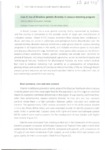Please use this identifier to cite or link to this item:
http://www.alice.cnptia.embrapa.br/alice/handle/doc/934000| Title: | Use of Brazilian genetic diversity in cassava breeding program. |
| Authors: | FUKUDA, W. M. G.  |
| Affiliation: | WÂNIA MARIA GONÇALVES FUKUDA, CNPMF. |
| Date Issued: | 2009 |
| Citation: | In: MARIANTE, A. da S.; SAMPAIO, M. J. A.; INGLIS, M. C. V. (Ed.). The State of Brazil´s plant genetic resources: second national report : conservation and sustainable utilization for food and agriculture. Brasília, DF : Embrapa Technological Information, 2009. p.116-119 il. |
| Description: | In Brazil, Cassava has a wide genetic diversity chiefly represented by landraces, and the country is considered as the possible center of origin and diversification of cultivated cassava. About 4,132 cassava accessions have already been catalogued in Brazil, and they are stored in collections and germplasm banks disseminated over the national territory. Brazilian diversity constitutes a wide genetic base for cassava breeding programs in ali tropical areas in the world, as it includes resistance genes to main pests and diseases affecting this crop. Furthermore, these genes allow adaptation to different edapho-climatic conditions. Indeed, genetic variability had already been identified for almost ali features, including morphological, agronomic, as well as nutritional quality and technological features. Variations for physiological features are more seldom studied, but there is evidence indicating high variability as a consequence of temperature, photosynthesis and sensitivity of stomata to relative humidity of the air. Although Brazil's cassava genetic resources are not very much exploited relative to the collections' size, its use is extremely successful in our country. |
| NAL Thesaurus: | cassava breeding |
| Keywords: | Genetic diversity |
| Type of Material: | Parte de livro |
| Access: | openAccess |
| Appears in Collections: | Capítulo em livro científico (CNPMF)  |
Files in This Item:
| File | Description | Size | Format | |
|---|---|---|---|---|
| UseofBraziliangenetic...0001.pdf | 1.4 MB | Adobe PDF |  View/Open |









